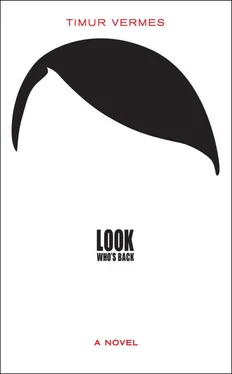I think we can work with that.
Timur Vermes’ cutting satire offers a unique perspective on our modern, media-bloated world, in which celebrity is worshipped above all else. The rapid progress of globalisation over the past two decades means that the most of the material in the novel will resonate with audiences in all Western societies rather than just in Germany. But for those readers who feel they may have missed some or many of the cultural and historical references, what follows is a brief résumé.
Adolf Hitler (1889–1945), we dare assume, is sufficiently well known for no introduction to be necessary. A few biographical notes up to his takeover of power in 1933, however, may serve to clarify some of the observations made in the book. Having left school at sixteen, Hitler moved to Vienna where he supported himself by working as a casual labourer and selling his watercolours. Twice rejected by the Academy of Fine Arts, Hitler fell into poverty, living in a shelter for the homeless, then a men’s workhouse. He volunteered immediately to fight in 1914 and was awarded the Iron Cross for bravery. After the end of World War I, Hitler moved to Munich where he joined the embryonic National Socialist party and soon gained a reputation as an orator. After the failed Beer Hall Putsch of 1923, Hitler was sentenced to five years’ imprisonment, but served only one, during which time he wrote Mein Kampf . Following his early release he rebuilt the party, became its undisputed leader, and the meteoric rise of the Nazis began. Eva Braun (1912–45)was his long-term partner who only became the Führer’s wife for the last couple of days of their life. Having already undertaken a couple of unsuccessful suicide attempts in the 1930s, she finally managed it together with Adolf in the bunker.
One of the great ironies of the Third Reich was that neither its Führer nor his three leading henchmen were the embodiment of the Aryan ideal as propagated by National Socialism. Hermann Göring (1893–1946), the portly, arrogant head of the Luftwaffe — one of his many roles — was addicted to morphine as well as fine clothes. Sentenced to death at Nuremberg, he cheated the hangman by swallowing cyanide on the eve of his execution. Heinrich Himmler (1900–45), weaselly head of the S.S. and one of the key figures of the Holocaust, also committed suicide after capture by British forces, having failed in his attempt to negotiate a peace treaty with the Allies behind Hitler’s back. The physically frail Joseph Goebbels (1897–45),Hitler’s greatest fan and Nazi Germany’s propaganda chief, killed his children before he and his wife took their own lives in Hitler’s bunker.
Martin Bormann (1900–45),who gets frequent mention in the novel, became very close to Hitler in later years; as the Führer’s trust in him grew, so did his power within the regime, while his relationship with Himmler, amongst others, became increasingly antagonistic. For many years after the war, uncertainty prevailed over Bormann’s fate, and the West German government did not officially abandon the hunt for him until 1971. It was later accepted that he was killed while trying to escape from Berlin at the end of the war. Heinrich Müller (1900–45), chief of the Gestapo, was another leading Nazi whose death has remained a matter of mystery. It is assumed that he died in May 1945, but no physical remains have ever been found.
Of the other Nazi figures referred to here, perhaps the best known is Rudolf Hess (1894–1987), Hitler’s deputy from 1933 to 1941, at which point he took the madcap decision to pilot a plane to Britain in a solo attempt to negotiate with the government. Hess’s Messerschmitt crashed in Scotland and his peace efforts came to naught. He was sentenced to life imprisonment at Nuremberg, and he lived out the rest of his life at Spandau prison in Berlin, where for more than twenty years he was the only inmate, guarded by soldiers and warders from the four victorious Allied Powers. Albert Speer (1905–81)is best known for his role as chief architect of the Third Reich, although he also became minister for armaments during the war. Speer was responsible for the New Reich Chancellery, which Hitler refers to in the novel, as well as the Nuremberg parade grounds. After the war Speer was imprisoned for twenty years for his complicity in the crimes of the Third Reich. Ernst Röhm (1887–1934)was on the radical wing of the Nazi Party that was pressing for social revolution. Head of the S.A., Röhm was executed as part of the Night of the Long Knives in summer 1934. Reinhard Heydrich (1904–42), referred to in the novel by first name only, was the brutal and ruthless deputy protector of occupied Bohemia and Moravia, as well as one of the main instigators of the Holocaust. Heydrich was assassinated in Prague by a group of Czech and Slovak officers following orders from their government-in-exile. Julius Streicher (1885–1946), “the Jew Baiter of Nuremberg”, founded the newspaper, Der Stürmer , which Hitler recalls in the kiosk. A virulent anti-Semite, his behaviour was condemned as excessive by other leading Nazis, and his star waned after 1938, in spite of his close relationship with the Führer. Streicher was hanged for his incitement of the Holocaust, even though he had not been directly involved. Another leading Nazi executed at Nuremberg was Joachim von Ribbentrop (1893–1946), wine salesman turned foreign minister, via a spell as ambassador to London. An incorrigibly vain man, Ribbentrop added the “von” to his name through his aunt’s aristocratic connections. Robert Ley (1890–1945)was head of the German labour front, which established the “Strength through Joy” leisure organisation for the masses. He committed suicide while on trial at Nuremberg. Walther Funk (1890–1960)served as a propaganda minister in the Third Reich, later becoming economics minister. He was imprisoned after the war, but released in 1957 due to poor health. Ernst Hanfstaengl (1887–1975)was an early supporter of Hitler who introduced him into Munich society and later worked as chief of the foreign press bureau for the Nazis. He fell from favour in the mid-1930s and later fled Germany. Franz Schädle (1906–45)was the commander of the Führer’s S.S. bodyguard; he shot himself the day after Hitler committed suicide. Ulrich Graf (1887–1950)and Max Ernst von Scheubner-Richter (1894–1923)were both shot during Hitler’s Beer Hall Putsch of 1923. The former survived, despite having taken eleven bullets to the body.
A number of leading military figures are cited throughout the book. Chief amongst these is Grand Admiral Karl Dönitz (1891–1980),commander-in-chief of the German navy from 1943. Hitler nominated Dönitz head of state after his death; there was little left for him to do but authorise Germany’s unconditional surrender on 7 May, 1945. Sentenced to ten years’ imprisonment at Nuremberg, Dönitz lived almost another twenty-five years following his release in 1956. Wilhelm Keitel (1882–1946),supreme commander of the armed forces, and his deputy Alfred Jodl (1890–1946),likewise played leading roles in the surrender. Both were tried and hanged as war criminals at Nuremberg. Heinz Guderian (1888–1954)and Walther Wenck (1900–1982)were both army generals during the war, as was Felix Steiner (1896–1966),whose failure to launch an offensive from Berlin in April 1945 was the trigger for Hitler’s fit in the famous scene from Downfall , endlessly parodied on YouTube. Friedrich Paulus (1890–1957)commanded the German forces in the Battle of Stalingrad, after which he spent ten years in Soviet captivity. Walter von Brauchitsch (1881–1948)was commander-in-chief of the German army at the beginning of the war and one of the key players in the Blitzkrieg against France. When the army failed to take Moscow, however, Brauchitsch fell from favour.
Читать дальше












